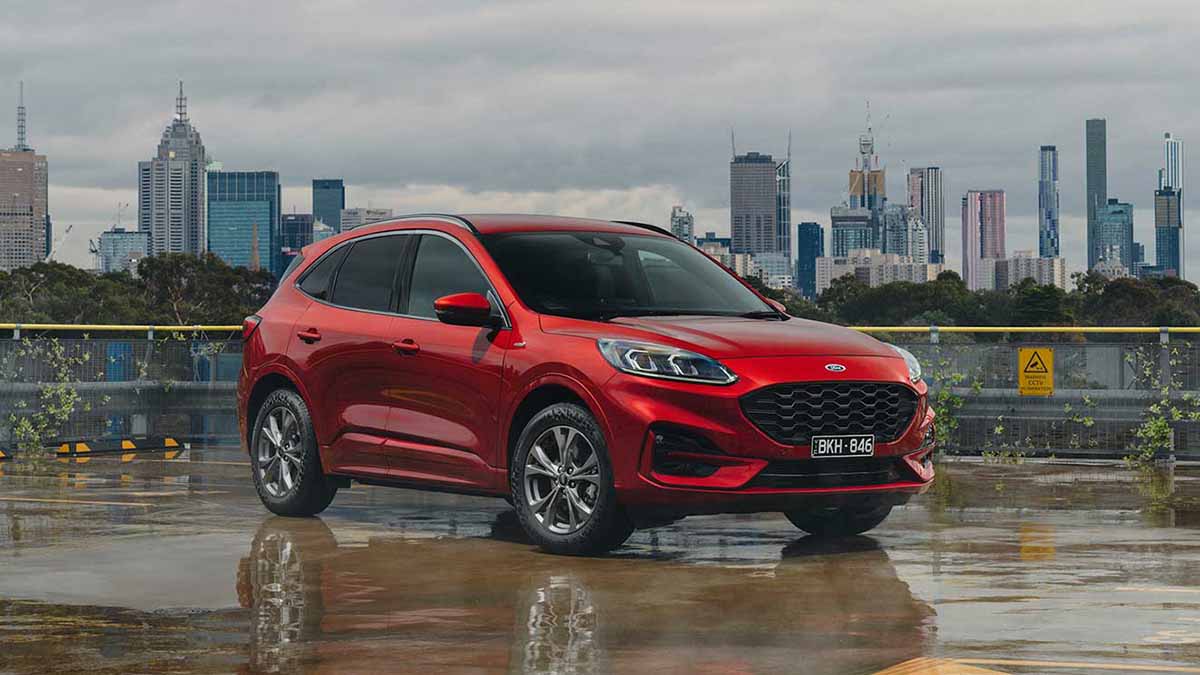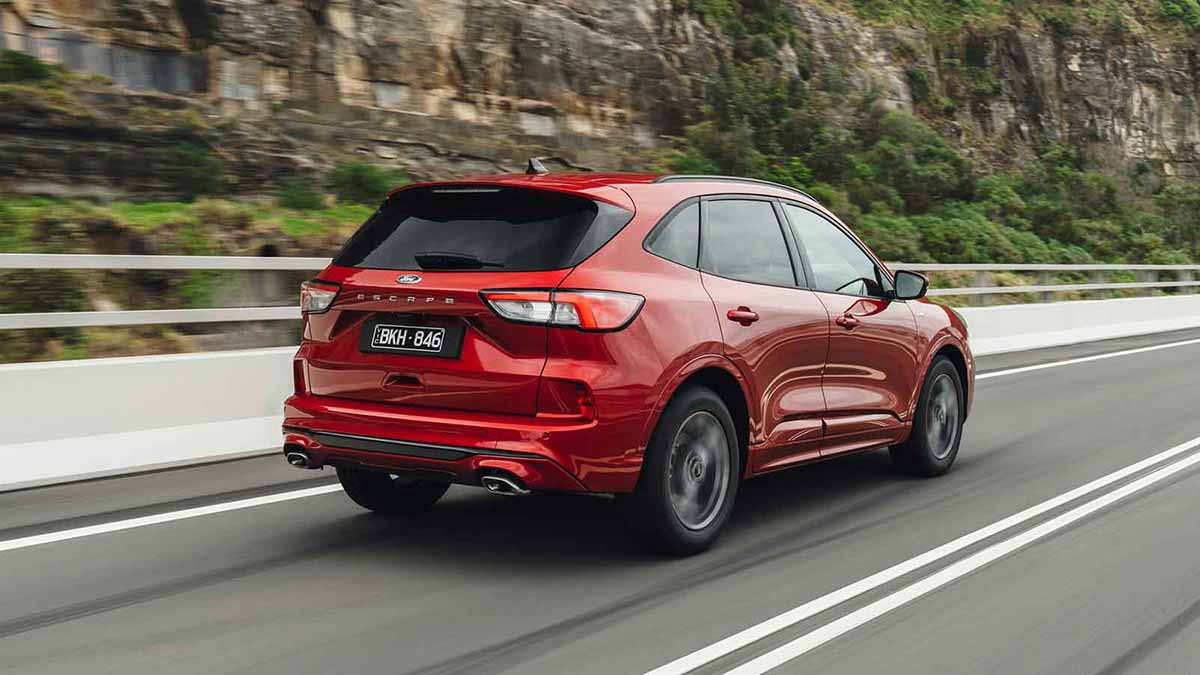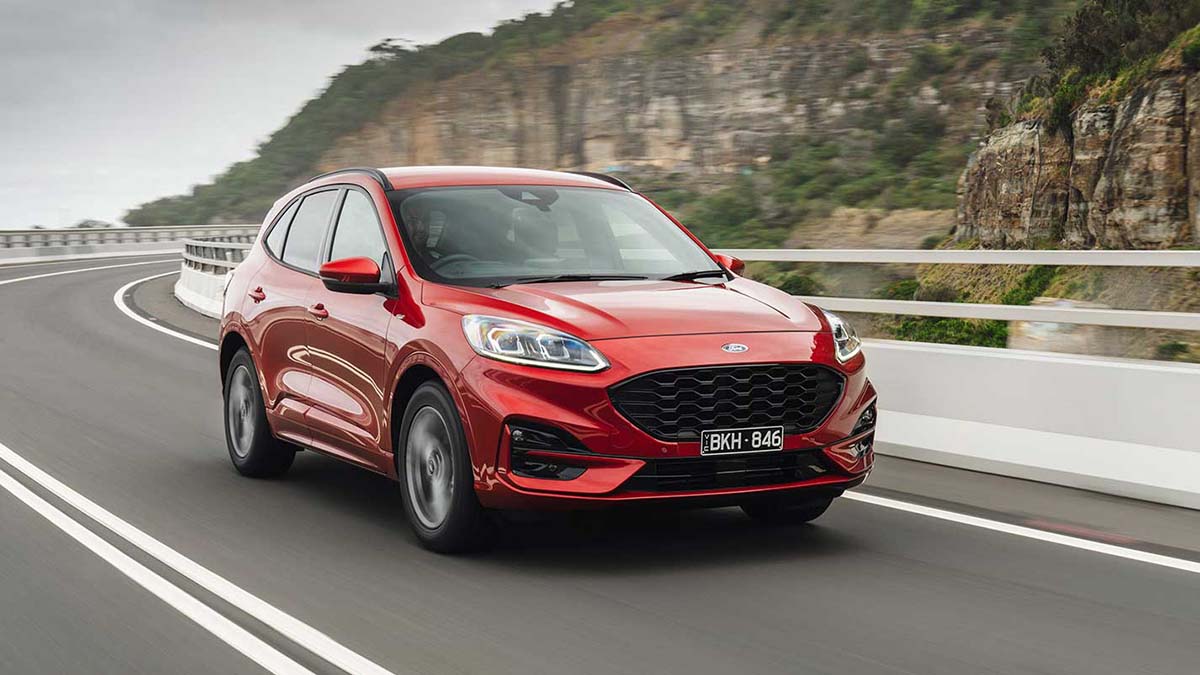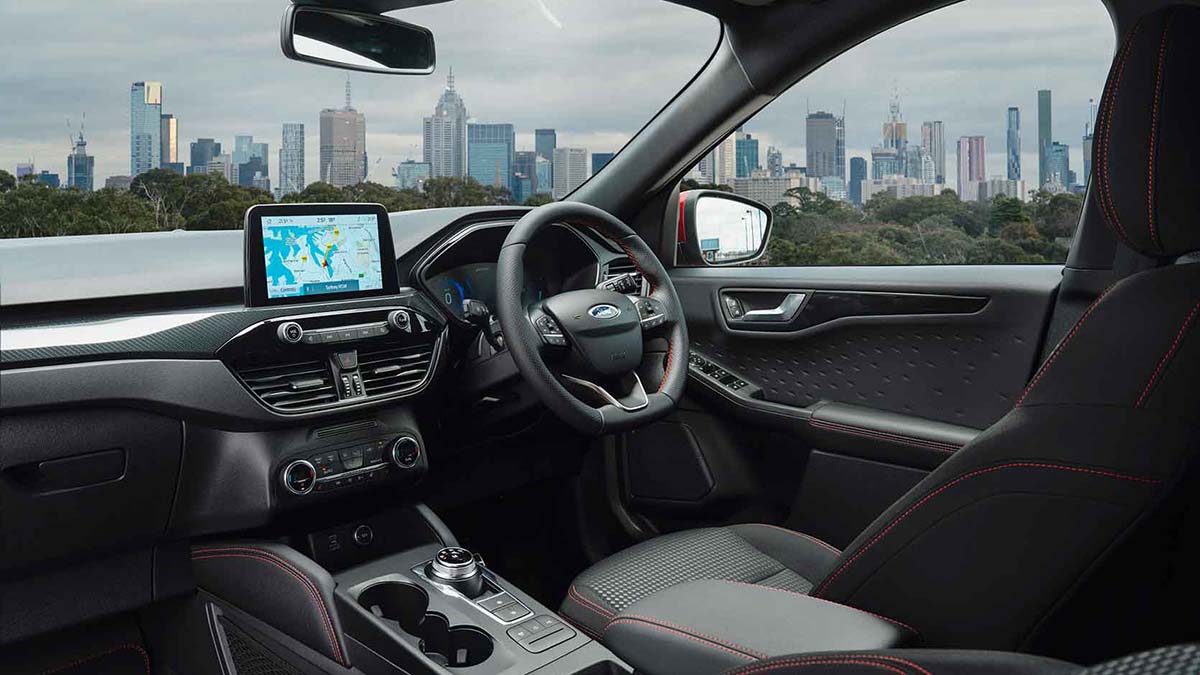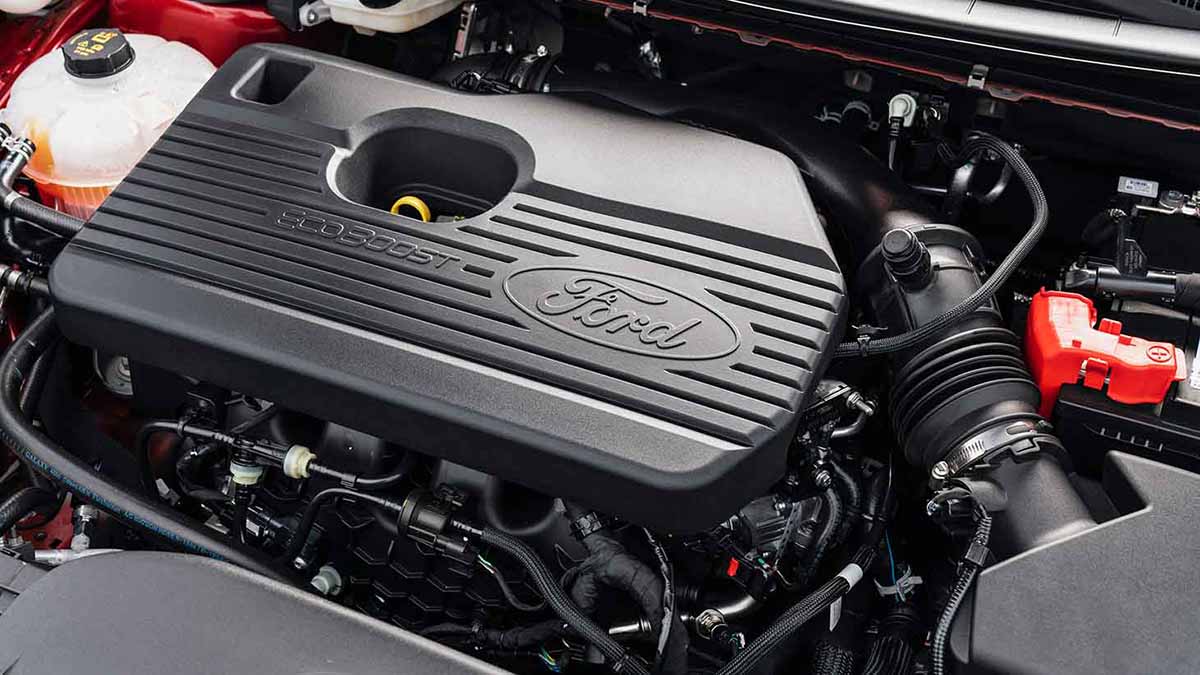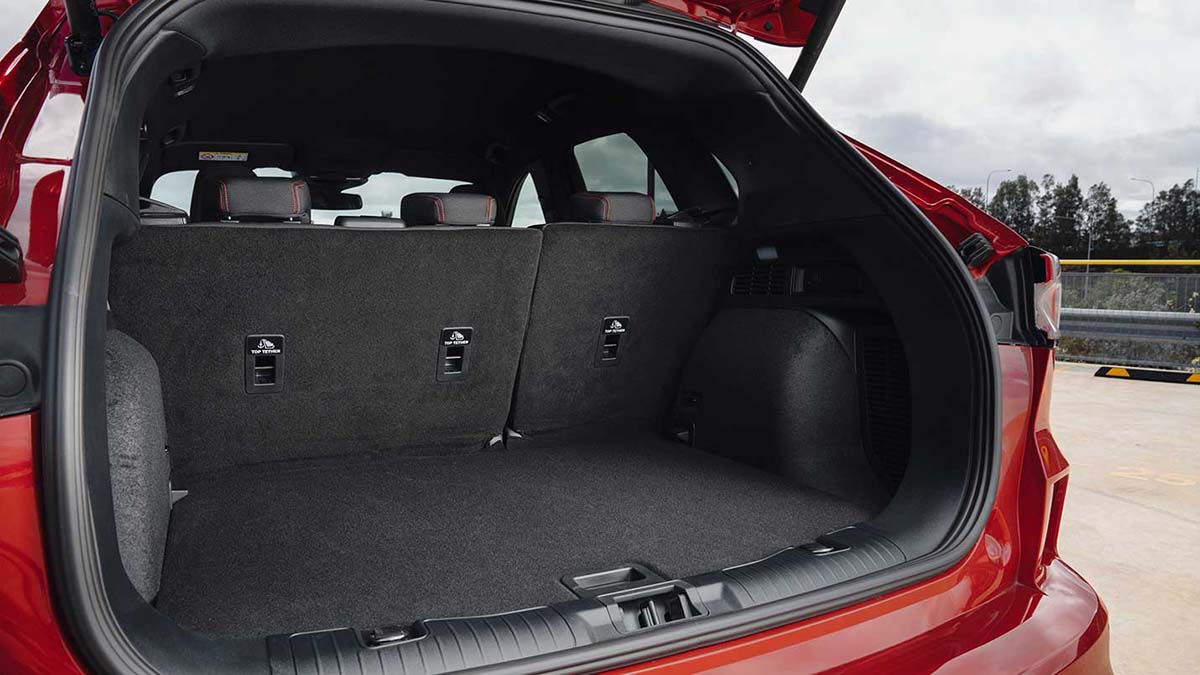Ford Escape ST-Line 2021 road test review

The new-generation Ford Escape medium SUV in ST-Line guise is put through its paces.
Ford’s previous-generation Escape was a bit of an underrated gem among the popular medium SUV set. It was visually appealing, dynamically superior to most of its rivals and pretty decent value. But there were negatives too. The interior and dash were a mess, and the turbo-petrol engine was thirsty. The all-new version that launched in 2020 saw the Escape mature into a larger, more serious offering, thanks to new underpinnings shared with the impressive Focus hatch. Is the Escape still the playful underdog, or has Ford engineered the fun out of the latest version?
Thumbs up
Punchy turbocharged engine, playful handling, big boot, spacious interior, generous storage.
Thumbs down
Jerky transmission, torque steer, fuel economy, strange driving position.
How much does the Ford Escape cost?
The new Escape is available in three model grades – base front-wheel drive (FWD) Escape, FWD or all-wheel drive (AWD) ST-Line, and FWD and AWD Vignale. Opting for AWD adds $3000 to the price. They’re all powered by Ford’s 2.0-litre turbocharged petrol engine, but a plug-in hybrid (PHEV) will b available next year. This time around, there is no diesel option. Pricing ranges from $35,990 for the entry-level variant to $52,940 before on-road costs for the PHEV.
We sampled the FWD ST-Line, priced at $37,990. Our test car was fitted with premium paint ($650) and the ST-Line pack ($1950), including a hands-free power tailgate, heated front seats, LED headlights, and a head-up display. That lifted the price to $40,590.
The Spanish-built Escape ST-Line represents decent value, and it’s got roughly the same level of standard gear found in equivalent mid-range FWD variants of the Toyota RAV4, Hyundai Tucson and Mazda CX-5.
What safety features does it have?
Along with a 5-star ANCAP rating, Ford has fitted all Escape variants with a generous level of standard safety gear (see table below).
The lane-keeping aid successfully keeps the car centred in the lane without bouncing from line to line. It’s an impressively smooth system, as is the adaptive cruise.
What's the space like inside?
We have commented before about Ford’s improved interior design and overall quality, and it’s true of the Escape too. While it’s not class-leading, it’s well-executed and, thankfully, a significant improvement over the old model.
The dash will be familiar to anyone who has driven the Focus with which it shares Ford’s C2 platform. Instead of a regular gear shifter, the Escape uses a dial which can take some getting used to.
As Ford’s sports-themed variant, the ST-Line includes a flat-bottom steering wheel – with easy to identify controls – and red stitching throughout.
There’s no shortage of storage for personal items, with a big central bin, space for large bottles in the doors and other smaller nooks throughout.
Ford’s top-notch digital instrument cluster has a crystal-clear adjustable display, making it easy to find vehicle information such as fuel economy.
The 8.0-inch central touchscreen that houses the Sync3 multimedia system functions well and is easy to navigate, but it’s not the benchmark it once was. It’s now middle of the pack compared with rivals, notably Kia/Hyundai, Mazda and Volkswagen.
The Escape’s front seats are comfortable, and upper body bolstering is supportive, but the driver’s seat, in particular, is set quite high. We lowered it as much as we could but struggled to find the perfect driving position.
The pedals feel like they’re positioned a little too far to the left of the footwell. If they were a couple of centimetres to the right, they’d be fine.
In terms of dimensions, the new Escape is 44mm wider and 89mm longer than the old model, placing it at the larger end of the medium SUV segment. A 20mm longer wheelbase has freed up more occupant space.
There’s ample head, leg and toe room in the second row and plenty of space across the bench. Rear seat occupants have access to knee-level air vents, small bottle storage in the doors and a pair of USB outlets.
The 60/40 split-fold seats are lowered via a lever next to the outboard seats or a lever in the boot. When stowed, the expanded cargo floor is almost flat.
With all seats in place, the Escape has an impressive 556-litre boot, a little more than the Hyundai Tucson (539L) and Honda CR-V (522L), but not as sizable as the Toyota RAV4 (580L). The Escape has a space-saver spare wheel and some additional storage under the boot floor.
How does it drive?
The previous Escape was one of the driver’s picks of the medium SUV set, so the new-generation model has quite the reputation to live up to.
With power and torque of 183kW/387Nm from the 2.0-litre, four-cylinder, turbocharged petrol engine, only the Jeep Cherokee (200kW) has more power in the segment, but it can’t beat the Escape for torque. The Ford’s figures are an improvement of 7kW/42Nm over the old Escape.
Acceleration feels as brisk as the previous version, and there’s no hint of turbo lag from a standing start. There is, however, quite a bit of hesitation when accelerating in second gear. Overtaking is a breeze, and the Escape loses no momentum on steep ascents.
Hard acceleration from zero will produce torque steer and tyre squeal, and the eight-speed automatic transmission is jerky. It’s not the smoothest powertrain, but it’s still fun to drive.
Ride quality on urban streets is comfortable, but you’ll feel potholes and plastic road reflectors when driving at speed.
Thankfully, the latest Escape still handles with the playfulness of a small hatch. It maintains its composure pushing out of tight corners, and is settled on unsealed road edges.
The brakes proved themselves when a car in front stopped suddenly. The stop-start engine system is seamless, and the cabin is well insulated.
The previous turbo-petrol Escape was incredibly thirsty when it came to fuel use. It appears the new version still likes to drink. Ford says it will consume 8.6 litres of fuel per 100 kilometres. We recorded 11.4L/100km.
The verdict
With this new version, the Escape feels like it has grown up. It’s still playful and fun, but it’s a little more serious now. The powertrain lacks the refinement you’d find in a Volkswagen Tiguan, but it’s still a hoot to drive. The Escape is definitely worth considering if you’re in the market for a medium SUV.
|
Pricing |
List price: $37,990 before on-road costs. Price as tested: $40,590 before on-road costs. Model range: $35,990 to $49,590 before on-road costs. |
|---|---|
|
Drivetrain |
2.0-litre four-cylinder turbocharged petrol engine, eight-speed automatic transmission, front-wheel drive. Power: 183kW@5700rpm. Torque: 378Nm@3100rpm. Wheels: 225/60 R18. |
|
Fuel |
RON 95 Premium ULP, 57-litre fuel tank. Consumption: 8.6L/100km (government test), 11.4/100km (RACV test). Emissions: 199g/km CO2 emissions. |
|
Standard safety |
5-star ANCAP rating, autonomous emergency braking with pedestrian detection, traffic sign recognition, lane keep assist with lane centring, blind-spot monitor, forward collision warning, adaptive cruise control with stop and go function. |
|
Standard features |
Keyless entry and start, wireless device charging, front and rear parking sensors, 8.0-inch touchscreen with DAB+ digital radio, sat-nav with voice recognition, Apple CarPlay/Android Auto. |
|
Warranty |
Five-year/unlimited kilometre warranty. Four years/60,000km capped-price servicing. Service intervals every 12 months/15,000km. |
